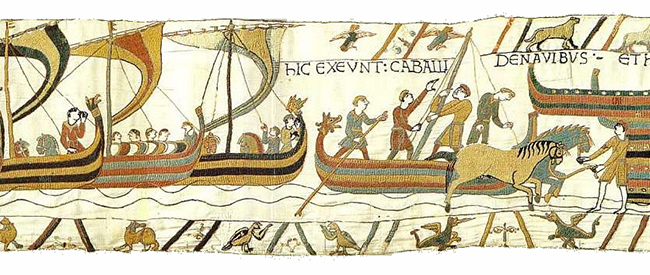
This article is an edited transcript of 1066: Battle of Hastings with Marc Morris, available on History Hit TV.
 Listen Now
Listen NowHarold Godwinson proclaimed himself king of England in 1066, and immediately braced for retaliation. His biggest rival was Duke William of Normandy.
Harold didn’t fear anything from the north, so he stationed his army and fleet – and we’re told it was the biggest army anyone had ever seen – along the south coast of England from the spring of that year, and they waited there for the whole summer. But nothing arrived. No one came.
Bad weather or a strategic move?
Now, the contemporary sources say that William didn’t sail because the weather was bad – the wind was against him. Since the 1980s, historians have argued that the weather idea was clearly just Norman propaganda, however, and that William was evidently delaying until Harold stood his army down. But the numbers don’t seem to work for that argument.
Historians with greater nautical experience would argue that when you’re ready, when D-Day comes and the conditions are right, you have to go.
The great problem with arguing that William was waiting with his army until Harold stood his own army down, however, is that the two men were facing the same logistical problem.
William had to keep his thousands-strong mercenary force in a field in Normandy from one week to the next, all the while dealing with the attendant difficulties of supply and sanitation. He didn’t want to watch his army consuming his carefully hoarded stockpile, he wanted to get going. Thus, it is perfectly credible to see how the Norman duke could have been delayed by the weather.
 Watch Now
Watch NowWe’re told by the Anglo-Saxon Chronicle that on 8 September 1066, Harold stood down his army because he couldn’t keep it there any longer; it had run out of material and foodstuffs. So the king was forced to disband his forces.
The invasion fleet sets sail
About four or five days later, the Norman fleet set sail from the place where William had mustered his fleet – the mouth of the River Dives in Normandy.
But he set out in terrible conditions, and his whole fleet – which he had carefully prepared for months and months – was blown, not to England, but eastwards along the coast of northern France to the neighbouring province of Poitiers and a town called Saint-Valery.
William spent another fortnight in Saint-Valery, we’re told, looking at the weathercock of Saint-Valery Church and praying every day for the wind to change and the rain to stop.
He even went to the trouble of exhuming the body of Saint-Valery himself and parading it round the Norman camp to obtain prayers from the whole of the Norman army because they needed God on their side. This wasn’t a cynical move – 1,000 years ago, the person who decided battles at the end of the day was believed to be God.

The Norman invasion fleet lands in England, as depicted by the Bayeux Tapestry.
The Norman must have thought, after weeks and weeks of rain and contrary winds, that God was against them and that the invasion wasn’t going to work. Then, on the 27 or 28 September, the wind changed direction.
This is where we are really reliant on only one source, William of Poitiers. People have it in the neck for William of Poitiers because he’s a propagandist source, but he was also one of William the Conqueror’s chaplains. So although he’s exaggerating everything all the whole time, he was very close to William, and thus a very important source.
The legend of William
He is the source that tells us that, as they’re crossing the Channel from Saint-Valery towards the south coast of England, William’s ship flew ahead of the others due to its sleek design. The Normans were crossing at night so William’s ship became separated from the rest of the fleet.
When they awoke the next morning, when the sun came up, the flagship couldn’t see the rest of the fleet, and there was a moment of drama on William’s ship.
 Watch Now
Watch NowThe reason why William of Poitiers’ version of events is slightly suspicious here is that it serves as a great character note for the Norman duke.
Like all great generals, he apparently displayed nothing but sangfroid in that period of stress and we’re told he just sat down to a hearty breakfast, washed down with some spiced wine.
By the time he had finished breakfast, the lookout saw ships on the horizon. Ten minutes later, the lookout said there were “so many ships, it looked like a forest of sails”. The problem with William of Poitiers is his attempts to emulate classical authors like Cicero. This is one of those occasions, because it looks like a legendary tale. It looks slightly suspicious.
There’s also a story from Robert Wace in the 1160s, which is probably apocryphal, where William is said to have landed on the shore and tripped over, with someone saying, “He’s grabbing England with both hands”.
When William landed in England, Harold wasn’t even there – by that time, the Vikings had landed. So in some ways, the delays actually benefited him, and he was able to establish himself in the south of England, before going on to defeat Harold in the Battle of Hastings later that month.














